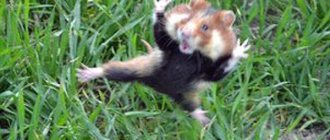How do you know if a hamster bite is dangerous? A brief overview of diseases and recommendations from veterinarians will help you avoid problems without panic and determine whether you did everything correctly.
Before you get a new pet, you need to know whether a hamster bite is dangerous. After all, small rodents, due to their unpretentiousness, are considered the best first pet for a child. But even without being a predator, a baby is capable of biting for a number of reasons, the first place among which is self-defense.
And given that domestic hamsters often bite, knowing the correct procedure will allow you to avoid false alarms and, at the same time, not lose sight of the real threat.
The hamster has very sharp teeth
Is a hamster bite dangerous?
Hamsters bite painfully and their bites take a long time to heal. This is due to the anatomical features of the jaws and the rather large size of the teeth. When a rodent bites, its incisors penetrate under the skin and move apart a little, which causes tissue rupture. A laceration can bleed quite profusely and takes much longer to heal than puncture or cut wounds of similar size.
However, the main danger is not the fact of the bite itself, but its depth, because an infection can be introduced into the wound, and it can only be properly disinfected from the outside. Therefore, it is very important to pay attention to the following:
- bites from domestic hamsters that live in the house for a long time and do not have contact with other animals pose virtually no threat to health;
- bites from a wild, recently acquired or unhealthy hamster should not be ignored, because you can become infected with dangerous diseases from it.
The average incubation period for diseases in a hamster is approximately 10 days. After purchasing it, it is worth organizing a two-week quarantine. During this period, do not introduce the animal to children and care for it yourself. And if after 10-14 days the hamster does not get sick, then you can introduce him to the child, since the answer to the question: “Is the bite of a pet hamster dangerous?” - you already know.
What to do if bitten by a hamster?
What could be the danger?
It is recommended to buy a hamster at a pet store. This way you will have almost one hundred percent confidence that the animal is healthy.
Pet hamsters purchased from people who breed these pets pose virtually no visible threat since they are not wild animals. However, it is worth knowing about diseases that hamsters can carry:
- parasitic infections;
- ringworm;
- rabies;
- listeriosis;
- tuberculosis;
- toxoplasmosis;
- tularemia.
It is unacceptable to bring a wild hamster to your child. In addition to the fact that such an animal may have innate aggression and is unlikely to become tame, it is quite capable of being a carrier of many diseases.
Contagious diseases of hamsters
Contrary to popular belief, hamsters very rarely get rabies. So far, not a single case of human infection with this disease after being bitten by a furry rodent has been recorded. But the list of possible diseases carried by pets, unfortunately, is not limited to one item.
The most dangerous diseases that hamsters can carry are:
- Tuberculosis. The pulmonary form is widespread. The sick animal gradually loses weight and loses activity.
- Listeriosis. It affects the central nervous system, which leads to impaired coordination of movements.
- Toxoplasmosis is dangerous for pregnant women as it can lead to impaired fetal development. It is tolerated by children and adults asymptomatically and does not cause complications.
- Tularemia. The disease progresses at the site of penetration, then spreads throughout the body. The external manifestation is similar to ulceration of the skin.
Toxoplasmosis is the only disease that can be transmitted to animals asymptomatically. Other diseases, one way or another, affect the appearance and activity of the pet.
Hamsters can be carriers of toxoplasmosis
Hemorrhagic fever with renal syndrome (HFRS)
Hemorrhagic fever with renal syndrome (HFRS) is a group of clinically similar diseases caused by hantaviruses of the family Bunyaviridae.
Symptoms of Hemorrhagic Fever with Renal Syndrome (HFRS) usually develop within 1–2 weeks after exposure to infected materials, but in rare cases can take up to 8 weeks to develop. Initial symptoms appear suddenly and include severe headaches, back and abdominal pain, fever, chills, nausea and blurred vision. People may have facial flushing, sore or red eyes, or a rash. Late symptoms may include low blood pressure, acute shock, and acute renal failure, which can cause severe fluid overload. The severity of the disease varies depending on the virus causing the infection. Hantaan and Dobrava virus infections usually cause severe symptoms, while Seoul, Saaremaa and Puumala virus infections are more mild. Full recovery from rat disease may take weeks or months.
Hemorrhagic fever with renal syndrome occurs throughout the world. Haantan virus is widespread in East Asia, especially in China, Russia and Korea. Puumala virus is found in Scandinavia, Western Europe and Western Russia. The Dobrava virus is found mainly in the Balkans, while the Seoul virus is found throughout the world. The Saaremaa virus is found in Central Europe and Scandinavia. In America, hantaviruses cause another disease known as hantavirus pulmonary syndrome.
Hantaviruses are carried and transmitted by rodents. People can become infected with these viruses and develop hemorrhagic fever with renal syndrome after inhaling aerosolized urine, droppings, or saliva from infected rodents or after coming into contact with dust from their nests and cages. Infection can also occur when contaminated urine or other materials come into direct contact with broken skin or mucous membranes of the eyes, nose, or mouth. Additionally, people who work with live rodents can become infected with hantaviruses through the bites of infected rodents. Transmission from one person to another can occur but is extremely rare.
The gray or Norway rat (Rattus norvegicus) is a reservoir for the Seoul virus.
I was bitten by a hamster, what should I do?
Even the most affectionate animal can bite if it is hurt, frightened, or forced to defend its territory. And you shouldn’t punish the hamster for this, because he simply won’t understand why he was punished, but he may harbor a grudge. Therefore, carefully place the animal back into the cage and tend to the wound.
If the hamster bites hard enough to cause blood, then first wash the wound with antibacterial or laundry soap. Then treat the bite site with hydrogen peroxide or brilliant green and, if necessary, cover with a band-aid.
After treating the wound, you should carefully examine the hamster for signs of disease. Pay special attention to your pet's face and abdomen. If there is no swelling accompanied by partial baldness, purulent discharge from the eyes, nostrils and ears, and no visible signs of bites, then release the animal back into the cage and carefully monitor it over the next two to three days for changes in behavior.
In cases where there are no changes and the animal maintains its previous habits, you can be calm. But if, during examination of the rodent or for several days after the bite, signs uncharacteristic of a healthy animal were revealed, then you should immediately go to the veterinary clinic. A thorough examination of the hamster will allow you to find out whether the disease is dangerous for humans.
A pet hamster bite does not require treatment
If a child has been bitten by a wild hamster, whose health cannot be assessed, then the first step is to get a preventive vaccination against tetanus. Also pay attention to the wound healing process and symptoms such as:
- temperature increase;
- enlarged lymph nodes;
- inflammation of the bite site.
If any of the symptoms appear, consult a doctor immediately.
Be sure to tell your child what to do if bitten by a hamster. This is necessary, first of all, for your peace of mind, because children who have been bitten often forcefully throw the animal that hurt them, which entails serious consequences. Often the hamster dies from the injuries received or is sick for a long time, which forces the parents to raise a false alarm.
Possible reasons
A hamster bites when it senses danger.
A pet will not bite its owner, especially to the point of drawing blood, without a good reason. We will look at the main factors that provoke aggression in a hamster.
- Fear. The case when a child takes the hamster from above, holding its back. The animal does not understand what is happening, gets scared and defends itself by biting. In such a situation, it can bite its owner repeatedly.
- A hamster can be frightened by a sudden movement or any unexpected action at the moment when a child is playing with it.
- Your baby's smelly hands can arouse your hamster's interest in a new smell. Especially if it smells like something tasty, and the animal is also hungry. As a rule, such bites are single and shallow.
- An attempt to protect themselves or their offspring is observed in pregnant females or animals that have recently given birth. If this is your situation, you need to know that it is unacceptable to handle either a pregnant or recently given birth hamster or her babies.
- Trying to grind my teeth. Hamsters have long, sharp incisors and front teeth that continue to grow throughout the animal's life. Therefore, the animal needs constant grinding. If a rodent does not have objects in its cage to sharpen its teeth on, it may bite your hand when it finds itself outside its territory. Therefore, it is recommended that the animal in the cage have a branch of a fruit tree or root parts of plants, a cracker.
- The hamster will bite if the child squeezes it tightly in his hand, that is, it will cause direct pain to the animal.
- A bite can occur in a situation where the hamster has just been brought into the house. The animal is frightened by a change of environment; it needs time to adapt. It is unacceptable to immediately pick it up.
My son loves hamsters very much. Now we have two animals, Snowball and Shustrik. These are atypically tame hamsters, who have never bitten, calmly run around and play.
Consequences of bites
Hamsters have decent sized teeth. If a hamster bites until it bleeds in the area in close proximity to the tendons, they may be damaged, which entails an inflammatory process and disruption of the normal functioning of the fingers. The problem can be easily solved by promptly contacting a specialist.
There are no other complications from the bite of a healthy hamster, but if the animal is a carrier of infectious diseases, then untimely contacting a medical facility can lead to various complications. Therefore, do not trust your child to care for an animal that looks sick.
And most importantly: do not give up your pets. Remember that a bite from any animal can be dangerous, and hamsters are one of the most harmless pets in this regard. And if you or your child are nevertheless bitten by a hamster, then knowing what to do, you reduce the likelihood of infection, which is not particularly high, but is possible.
Prevention on the street
While the child is small, it is easy to cover him with a mosquito cover right in the stroller. In some cases, it is convenient to use protective clothing or tents with mosquito nets. In all other situations, repellents become almost the only protective measure. Modern repellents typically use one of these two main active ingredients - DEET or picaridin.
DEET (diethyltoluamide) is the most commonly used broad-spectrum ingredient that is effective against mosquitoes, biting flies, fleas and ticks. In most cases, a repellent containing up to 10% DEET will prevent mosquito bites. In areas at high risk of insect-borne infections (where malaria, Ross River virus, Barmah Forest virus and Dengue fever occur), repellents with a DEET concentration of 15–30% should be used.
DEET can be safely applied to cotton, wool and nylon, but can damage spandex, rayon, acetate and leather clothing. DEET can dissolve plastics and vinyl (such as sunglass frames or watch bands).
Picaridin is a new repellent ingredient that is odorless and less sticky than DEET. May be more pleasant to use, does not dissolve plastic. Studies have shown that picaridin is as effective as DEET; however, its protection is less long-lasting and it will need to be applied more frequently. Products containing 10% picaridin will prevent insect bites in most situations.
Safety of using repellents in children
Before use, read the label, assess the level of DEET or picaridin in the product, and use the repellent only as directed by the manufacturer.
Follow simple rules:
- Choose roll-on medications over aerosols if you have a choice.
- Apply a moderate amount of the drug to exposed skin.
- Do not apply the drug to cuts, wounds or irritated skin.
- Do not apply to areas around the eyes or mouth (in case of accidental contact with eyes, rinse immediately with plenty of water!).
- Do not apply to the palms or fingers of small children.
- When you return home, wash the repellent off your skin with soap and water.
- Keep repellents out of the reach of children.
- If you need to apply both sunscreen and repellent, apply the sunscreen first. Products that combine sunscreen and repellent are not recommended by experts, as sunscreen usually needs to be reapplied, but repellent does not.
Physical methods of protection
Mosquitoes are attracted to dark colors, so you should wear light-colored clothing that covers your wrists and ankles to reduce the likelihood of being bitten. If you are planning to travel to high-risk areas, it is recommended that you obtain medical advice before traveling; you may need additional vaccinations against infections and/or drugs to prevent malaria.
Stagnant water attracts mosquitoes, so stay away from dams, ponds, swamps and other areas with standing water.
To prevent mosquitoes from breeding near your home:
- Cover all water containers (including swimming pools) to prevent mosquitoes from laying eggs there.
- Empty all water containers when not in use.
- Change the water in used containers at least once a week.
- Cover cesspools and septic tanks to prevent mosquitoes from laying eggs in them.
- Remove excess vegetation from garden ponds and stock the ponds with fish.
- Avoid overwatering your garden.











